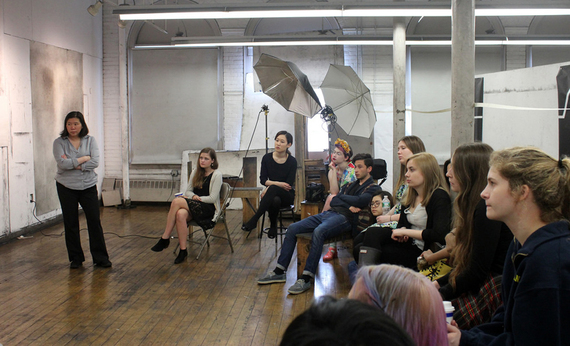"I am 23 years old, and I'm a beginning visual artist. I really want to get to a professional level, but I have no idea how to teach myself to get to that level. I can't afford to go to art school and I don't have much money for local classes and workshops. Is there any way I could do this on my own?"
At an individual level, there are a number of initiatives you can take to begin to train yourself. Most importantly, you have to invest many hours of daily practice over a period of several years. Don't be too precious with your work. Instead, maintain a high production rate so that you are churning out several finished pieces a week. Get several instructional books so that you can see contrasting ways of approaching the same topics and techniques. Experiment and work with a diverse range of media and formats. As a beginning student, exposure to different materials and approaches is initially much more important than trying to master one technique.
However, for even the most disciplined person, these directives barely skim the surface. The truth is that studying by yourself has major limitations. This is true for any field: musicians have to practice their instruments for several hours every day. However, no amount of individual practice will develop the skills they need to play with other musicians. If you can't play with other musicians, you can't function at a professional level. Visual art is no different; interaction with other artists is absolutely necessary. For people not enrolled in a degree program, taking a local class or workshop is the best way to meet other artists in person. Taking a class does require some kind of financial investment, but there's no way around it if you truly want to become a professional.
From the outside it may look like being a visual artist is just about putting in the hours to create the artwork, and it is true that many professional visual artists are by themselves when they create artwork. However, making the artwork is just one component of being a professional visual artist. A crucial part of being an artist is fostering in-depth relationships and maintaining a continuous dialogue with other artists in person. These conversations have multiple purposes: receiving critical feedback on your artwork, getting guidance from a more experienced artist, networking with other professionals, and much more.
A fundamental part of being an artist is the critique process. The critique process is ongoing for all artists, regardless of whether they are a student or professional. As an art student, group critiques were central to my growth. I had the opportunity to hear a diverse range of opinions and get concrete suggestions for how to improve. I learned just as much from my peers as I did from my professors. In addition to getting constructive criticism from my peers, I gained tremendously from seeing the artwork they created in response to the same assignments. Even though I work professionally now, I still actively seek out critiques from my colleagues on a regular basis.
Critiques provide significant insight on my work that I would never see on my own. Many artists spend numerous hours working on a piece, which usually involves staring at one image for a long period of time. When I'm working, I know that I inevitably lose perspective and I have to take a break in order to step outside of myself. Being too close to the piece, I don't trust myself to make sound judgments. I tend to get caught up in one aspect of the work which consequently results in my overlooking issues that should be obvious. I ask my colleagues for reactions at different stages of a project: during the brainstorming process, on my preparatory sketches, and on the final works. No artist can rely exclusively on themselves to critique their artwork; bringing in an outside eye is essential.
Artists have to develop an awareness of how their artwork might be received before they show their work publicly. First-year art school students in my classes are initially surprised by how easy it is for their intentions to be misinterpreted. I once had a student who brought in a self-portrait drawing which depicted a view of her head tilted back and her chin raised up which extended her neck. At the group critique, she described the drawing as a tranquil, contemplative self-portrait. To the rest of the class though, the neck in the drawing was a blatant phallus. The student was completely mortified that her drawing was interpreted this way. But, she had been so entrenched in her thoughts while she was working that she had failed to see the obvious. Nowadays, I require my students to get feedback from at least 2-3 other students while they are working on their assignments.
Working independently can get you started, but ultimately being a professional artist requires experience that can only be gained by working with other people. Being a professional artist is rigorous and demands that you assume multiple roles. On top of making the artwork, you have to be your own manager, publicist, archivist, photographer, webmaster, installer, and more. Prioritize placing yourself in a context with other artists, and in this way you will gain valuable experience that will put you on track to becoming a professional.
Ask the Art Professor is an advice column for visual artists. Submit your questions to clara(at)claralieu.com

